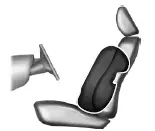Ford Mustang (2005-2014) Owners Manual: Side airbags
WARNING: Do not place objects or mount equipment on or near the airbag cover, on the side of the seat backs (of the front seats), or in front seat areas that may come into contact with a deploying airbag.
Failure to follow these instructions may increase the risk of personal injury in the event of a crash.
WARNING: Do not use accessory seat covers. The use of accessory seat covers may prevent the deployment of the side airbags and increase the risk of injury in an accident.
WARNING: Do not lean your head on the door. The side airbag could injure you as it deploys from the side of the seat back.
WARNING: Do not attempt to service, repair, or modify the airbag, its fuses or the seat cover on a seat containing an airbag, as you could be seriously injured or killed. Contact your authorized dealer as soon as possible.
WARNING: If the side airbag has deployed, the airbag will not function again. The side airbag system (including the seat) must be inspected and serviced by an authorized dealer. If the airbag is not replaced, the unrepaired area will increase the risk of injury in a crash.
The side airbags are located on the outboard side of the seat backs of the front seats. In certain sideways crashes, the airbag on the side affected by the crash will be inflated. The airbag was designed to inflate between the door panel and occupant to further enhance the protection provided occupants in side impact crashes.

The system consists of the following:
• a tag on the seat back indicating
that side airbags are found on
your vehicle
• side airbags located inside the
seat back of the driver and front
passenger seats.

• crash sensors and monitoring system with readiness
indicator. See Crash Sensors and Airbag Indicator later in
this chapter.
• front passenger sensing system.
Note: The passenger sensing system will deactivate the passenger seat-mounted side airbag if it detects an empty passenger seat.
The design and development of the side airbag system included recommended testing procedures that were developed by a group of automotive safety experts known as the Side Airbag Technical Working Group. These recommended testing procedures help reduce the risk of injuries related to the deployment of side airbags.
 Front passenger sensing system
Front passenger sensing system
WARNING: Even with Advanced Restraints Systems, children 12
and under should be properly restrained in a rear seating
position. Failure to follow this could seriously increase the risk of injury
or de ...
 Crash sensors and airbag indicator
Crash sensors and airbag indicator
WARNING: Modifying or adding equipment to the front end of
your vehicle (including frame, bumper, front end body structure
and tow hooks) may affect the performance of the airbag system,
increasing th ...
Other materials:
Body Sealer Types And Applications
Liquid Butyl Sealer
HB Fuller E709-19554-B or equivalent meeting Ford Specification
ESB-M4G162-A:
Does not run.
Is fast drying.
Remains semi-elastic.
Can be used for seam sealing on the floorpan, wheelhouse, body
rocker panels, door ope ...
Removal
1. Raise and support the vehicle.
2. Remove the rear wheel and tire assemblies.
3. CAUTION: Remove the rear brake calipers to prevent drag during the
drive pinion
bearing preload adjustment.
CAUTION: Do not allow the calipers to hang from the brake hoses ...
Removal
1. Disconnect the electrical connectors from the EGR vacuum regulator
solenoid, the
supercharger bypass vacuum solenoid, and the differential pressure
feedback EGR system.
2. Disconnect the vacuum hoses from the differential pressure feedback EGR
sy ...
